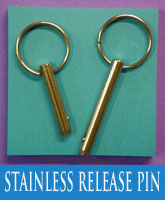The low-down on bamboo and how to make it into spars.
After going through all the work of building my sharpie, the last thing I was in the mood for was building the mast and spars. From the beginning of the project, I had it in mind to use only materials historically available in Florida, since I wanted to emulate a vessel that may have been built here. It may seem like a silly notion, but there you have it.
I had the same issue when I built my canoe sailing rig - I just didn't want to go through making my own spars. What I found then was cured timber that had been cut by the power company when clearing lines. I found a piece that would make a good mast and two more as spars for my lateen, though they had some intriguing "personality" of their own by way of knots and gentle bends in several directions. However, all three worked like champs and required only a little woodworking and varnish. Hard to beat the look of grown spars!
Then I "discovered" bamboo. I knew from the beginning it would be good to use, but at the time I didn't have the patience to learn more about it and find a source. I've overcome all that now.
Bamboo has a number of benefits and, for canoe sailing purposes, only a few drawbacks. First, the drawbacks: It isn't universally available, but you'll see many types generally are, and it can't be worked into a double taper like solid wood and it probably shouldn't be drilled through, unless reinforced.
Now, benefits. I'll keep this short as well. Bamboo is cheap, it's already round, it's already tapered, it is very light and very strong, it has natural flotation chambers, it's easy to work, it flexes and almost never snaps, and
(maybe the most important attribute) it makes great looking spars.
Now, not all bamboo is created equal. While many are useful for our purposes, some are too weak and should be avoided. I believe the most important consideration you must have when choosing what species to use is to either know specifically what you want, or deal with bamboo dealers who understand your needs. From what I've found, most dealers have an intimate knowledge of their product and should be able to help you, though dealing with fellow sailors helps!
Let's discuss the drawbacks of bamboo, and how to work with them, before we move on to the benefits. Bamboo doesn't grow everywhere, but, remarkably, it is found growing wild in many cold climates, and many cold-weather bamboo growers and dealers have successfully cultivated crops. Of course, one can always buy bamboo and have it shipped. I would suggest finding a source and speaking with them about your needs directly so both sides have an understanding of the application and limitations of the product.
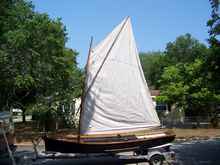 |
My 16 foot sharpie, at this size they were also referred to as “flat iron” skiffs due to their similarity to old flat irons heated on stoves for ironing. |
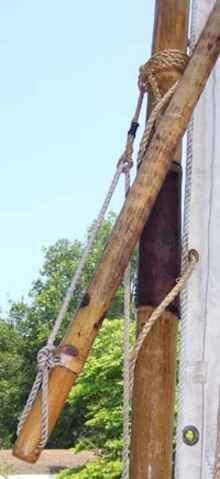 |
Base of the sprit spar showing the snotter rigging. Both ends of the spar and the clew end of the boom are reinforced with hardwood inserts to lend strength and create solid areas that can be pierced for rigging and lines. |
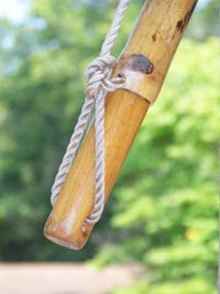 |
Closeup of the hardwood plug, which is deeply inserted into the bamboo spar. |
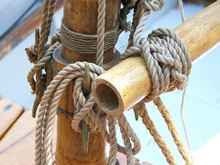 |
Tack end of the boom. No insert required since lashings are used. |
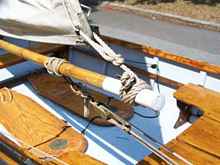 |
Clew end of boom painted white as decoration and to make boom end more noticeable. Note sheet connection is lashed to the boom. Any penetrations of the bamboo will weaken it and lead to longitudinal splitting. |
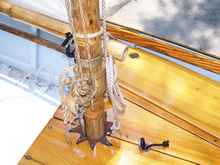 |
Since bamboo is tapered, wedges are used where the mast passes through the partner. I sailed without them at times but it's not recommended. |
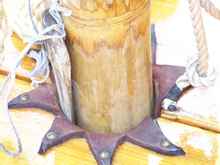 |
As Above. |
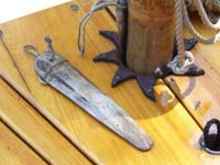 |
Bamboo wedges perfectly fit the bamboo mast! Cords are needed on them since they tend to tighten under sail. |
 |
A heavy section of bamboo was split and bound to the mast with bronze rod to allow for fasteners to avoid splitting. This “sacrificial” addition carried the fastener load while allowing the mast to flex without failing. These cleats were for main and jib halyards and snotter, which carried the most load. |
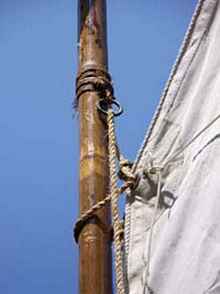 |
Main halyard passing through bronze ring. Since this is a sprit rig, the sail was generally never lowered, though I needed to retain the ability to do so. Note the ring is lashed to the mast. |
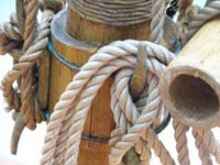 |
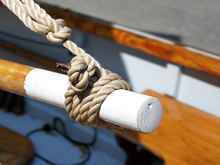 |
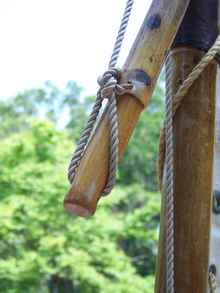 |
Unlike spars made out of lumber, bamboo can't be tapered to fit through a mast partner without an oversized hole. As you see in my photo, the partner is leathered and wedges are employed to brace the mast, which is not uncommon in any event. The mast step is bored to snugly accept the foot. Avoid the temptation to mount the hollow foot over a pin - it will lead to splitting. And, lastly, I wouldn't recommend drilling through unreinforced bamboo. Since bamboo's strength is longitudinal, with almost no cross-grain stability, a hole can lead to a lengthwise crack that could cause failure. If it maintains its integrity, bamboo will flex a lot without failure. I employ two methods to overcome this problem - lashing and reinforcement. As you see in the masthead photo, my halyard tackle (okay, it's just a bronze ring, but what the heck), is lashed in place. This is best done on the upper side of a node - the rigid portion seen as a ring separating the hollow sections - because it will provide a friction point and stop for your lashing. Of course, any good lashing that is pulled toward the bottom - the larger diameter part of the culm-will automatically tighten as it does so.
The second method - reinforcement - I have done two ways. In the mast base photos you will note I have added a bamboo collar to both reinforce that section and have a place for screw-mounting hardware. The collar is made from a little larger diameter section of this culm that has been split to fit over the section, then glued and itself reinforced with two thin bronze rods wrapped around it and secured in place. The hardware screws act in shear - which means they are pulled sideways instead of straight out - and just barely penetrate the mast itself. It's not the strongest arrangement, but more than adequate for this application. If a stronger mount where needed, the collar could be made of wood. The point is to avoid drilling holes in the unreinforced spar or mast itself.
Which leads to: The second method I use, seen in the boom and spar photos - the insertion of solid wood pieces into the culm. The sprit spar end uses a hardwood dowel deeply inserted and glued in place. The plug is drilled to accept the snotter rope. The boom end also has a wood plug, but I chose to cut it flush. This, too, has a hole drilled through the plug through which my outhaul passes. Note in both cases, holes are through the wood, not the bamboo alone, and stress is in shear, or pulling in-line with the spar.
Now, the advantages: this stuff is cheap, even if you have it shipped to you. Considering that it's already shaped and requires only minimal work to put it to use, it's much cheaper than building your own spars.
Bamboo's very light and very strong for its weight. Many types are stiffer than Sked 80 1.25" aluminum or 1.5" dia. Sked 40 aluminum often used on Junk Schooners. The maximum bow on a 21 foot pole is 3" or less. Not bad for grass, huh.
Being hollow, bamboo floats as long as you haven't punched holes through it for wiring, which leads to another benefit - you could punch small holes with a rebar or other long rod and pull wiring for a masthead light. The light mount could take advantage of the hollow you leave for it at top, and the battery could be mounted within a similar hollow at the foot. Add a small switch in the lower side and plug the top and bottom wire holes with sealant, and you have lights to awe your friends with! As for looks, I have sanded my nodes smooth and varnished all my spars, painted the boom end as you see, and it makes for very nice looking rigging. Many spars turned out of lumber look better painted, but bamboo has a beauty that needs to be seen.
When selecting bamboo, consider the flex of the spar and know that the material will flex quite a bit without breaking. If in doubt, once you have discussed your choice with a dealer, order material that may be a little larger in diameter than you think you need. Think of it like reefing - if you think about reefing under sail - then reef. Also buy longer sections than you need so you can trim the culm to length yourself. Once cut, treat the ends with a sealant like epoxy, varnish or some other product to keep bugs out of it. If you get green bamboo, know that it could lose up to 20 percent of its diameter as it cures, which takes about three to four months. Dry bamboo standing on end in the shade - you could hang it in a tree if you wanted. But store bamboo horizontally and out of the weather and sun, even if treated. I keep my rig hanging in my garage where it gets plenty of ventilation.
The photos I have here are from my sharpie. I restored my E. M. White-style canoe and used bamboo for the new rigging. I also use a bamboo pole for my push-pull tiller and a pushpole. There's a lot of value and uses in bamboo, which, as you know, is just a grass. A grass on steroids, that is!
From: Skinny Hull, the magazine of sailing canoes and kayaks and other skinny hulled boats.
|



